Importance of Nursing Care in Surgery
VerifiedAdded on 2020/03/13
|10
|2557
|39
AI Summary
This assignment highlights the critical role of nurses in ensuring successful surgical outcomes. It discusses their responsibilities during surgery, including maintaining a sterile environment, assisting surgeons, and monitoring patients. Post-surgery, nurses are vital for managing pain, preventing complications like infection, and providing emotional support to patients. The document emphasizes the importance of clear communication, teamwork, and adherence to safety protocols to deliver high-quality patient care in the operating room setting.
Contribute Materials
Your contribution can guide someone’s learning journey. Share your
documents today.
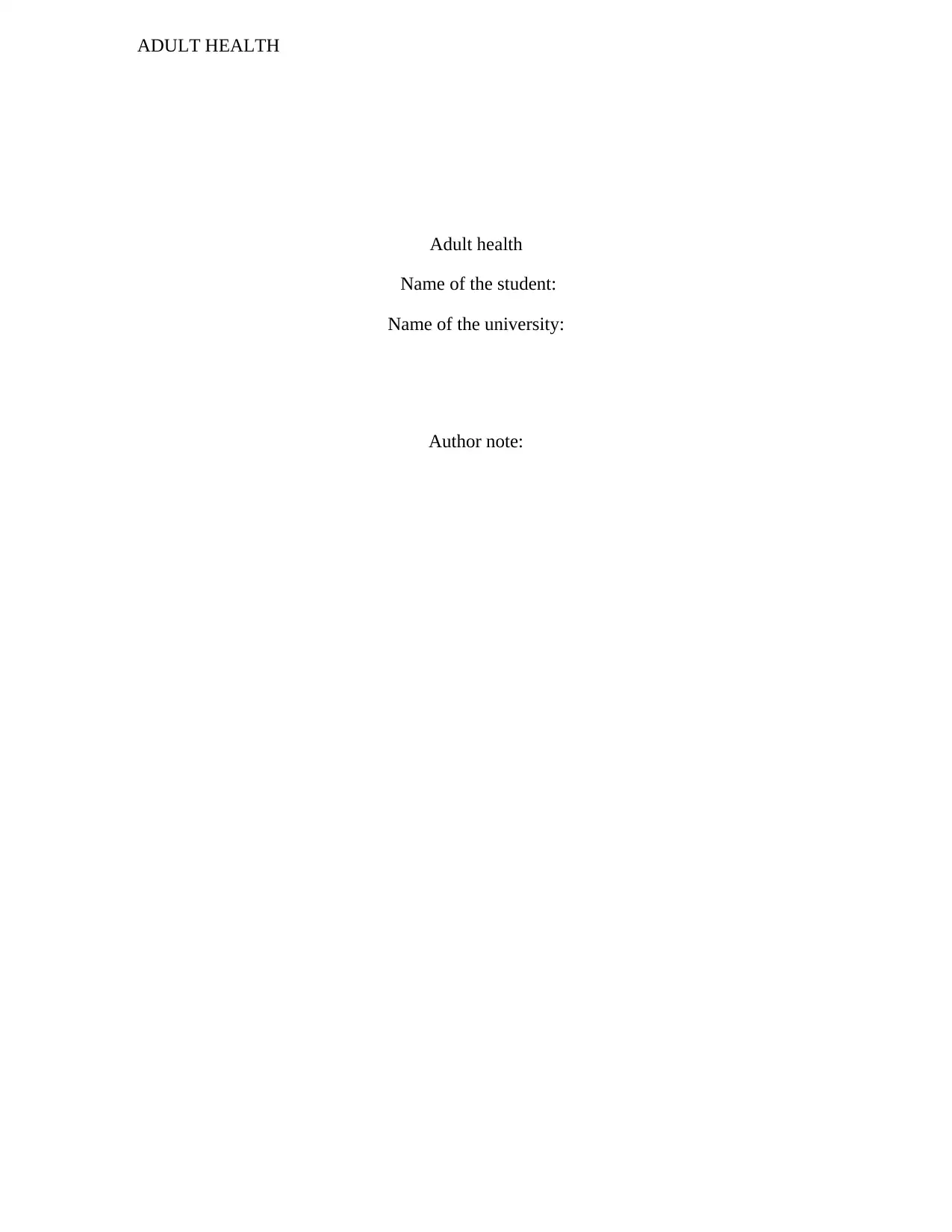
ADULT HEALTH
Adult health
Name of the student:
Name of the university:
Author note:
Adult health
Name of the student:
Name of the university:
Author note:
Secure Best Marks with AI Grader
Need help grading? Try our AI Grader for instant feedback on your assignments.
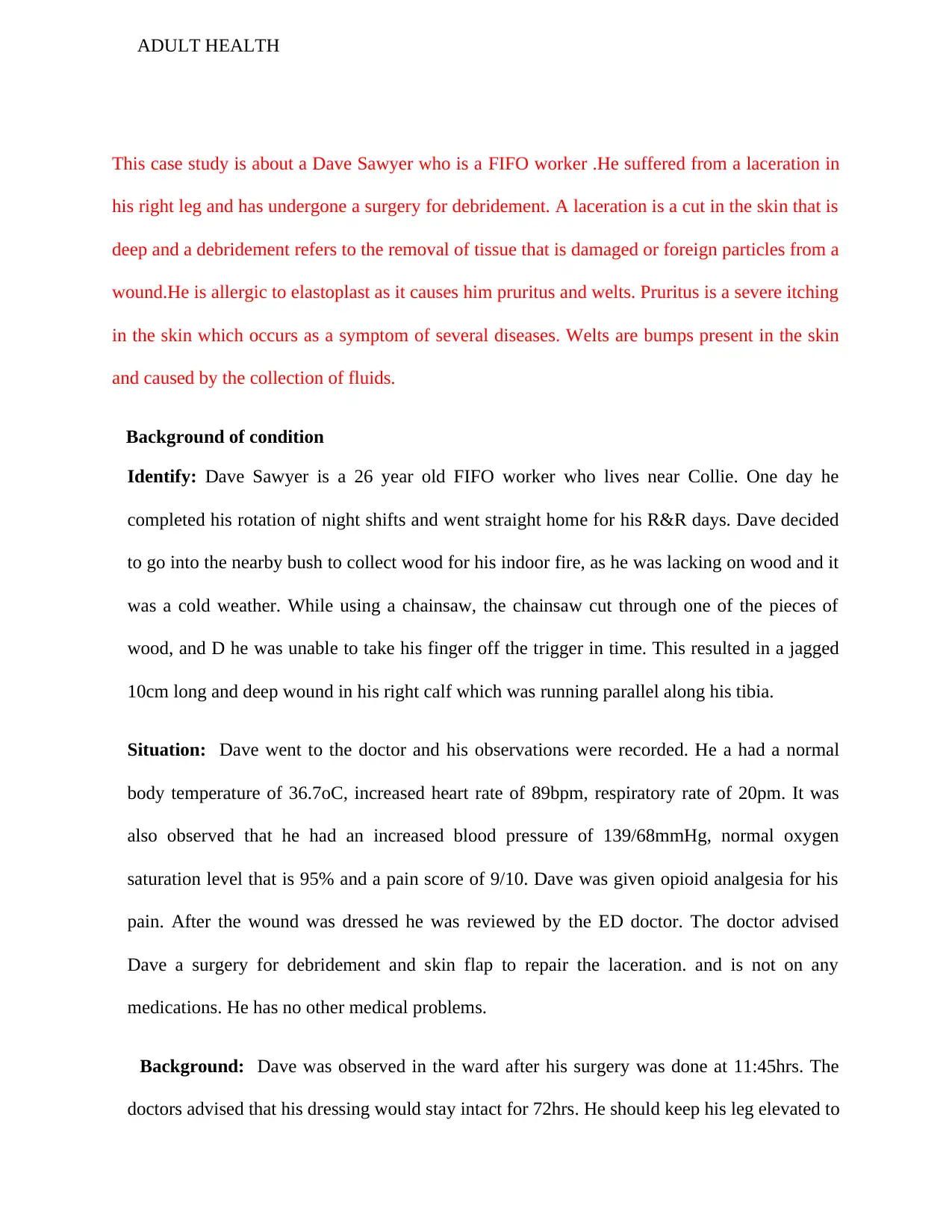
ADULT HEALTH
This case study is about a Dave Sawyer who is a FIFO worker .He suffered from a laceration in
his right leg and has undergone a surgery for debridement. A laceration is a cut in the skin that is
deep and a debridement refers to the removal of tissue that is damaged or foreign particles from a
wound.He is allergic to elastoplast as it causes him pruritus and welts. Pruritus is a severe itching
in the skin which occurs as a symptom of several diseases. Welts are bumps present in the skin
and caused by the collection of fluids.
Background of condition
Identify: Dave Sawyer is a 26 year old FIFO worker who lives near Collie. One day he
completed his rotation of night shifts and went straight home for his R&R days. Dave decided
to go into the nearby bush to collect wood for his indoor fire, as he was lacking on wood and it
was a cold weather. While using a chainsaw, the chainsaw cut through one of the pieces of
wood, and D he was unable to take his finger off the trigger in time. This resulted in a jagged
10cm long and deep wound in his right calf which was running parallel along his tibia.
Situation: Dave went to the doctor and his observations were recorded. He a had a normal
body temperature of 36.7oC, increased heart rate of 89bpm, respiratory rate of 20pm. It was
also observed that he had an increased blood pressure of 139/68mmHg, normal oxygen
saturation level that is 95% and a pain score of 9/10. Dave was given opioid analgesia for his
pain. After the wound was dressed he was reviewed by the ED doctor. The doctor advised
Dave a surgery for debridement and skin flap to repair the laceration. and is not on any
medications. He has no other medical problems.
Background: Dave was observed in the ward after his surgery was done at 11:45hrs. The
doctors advised that his dressing would stay intact for 72hrs. He should keep his leg elevated to
This case study is about a Dave Sawyer who is a FIFO worker .He suffered from a laceration in
his right leg and has undergone a surgery for debridement. A laceration is a cut in the skin that is
deep and a debridement refers to the removal of tissue that is damaged or foreign particles from a
wound.He is allergic to elastoplast as it causes him pruritus and welts. Pruritus is a severe itching
in the skin which occurs as a symptom of several diseases. Welts are bumps present in the skin
and caused by the collection of fluids.
Background of condition
Identify: Dave Sawyer is a 26 year old FIFO worker who lives near Collie. One day he
completed his rotation of night shifts and went straight home for his R&R days. Dave decided
to go into the nearby bush to collect wood for his indoor fire, as he was lacking on wood and it
was a cold weather. While using a chainsaw, the chainsaw cut through one of the pieces of
wood, and D he was unable to take his finger off the trigger in time. This resulted in a jagged
10cm long and deep wound in his right calf which was running parallel along his tibia.
Situation: Dave went to the doctor and his observations were recorded. He a had a normal
body temperature of 36.7oC, increased heart rate of 89bpm, respiratory rate of 20pm. It was
also observed that he had an increased blood pressure of 139/68mmHg, normal oxygen
saturation level that is 95% and a pain score of 9/10. Dave was given opioid analgesia for his
pain. After the wound was dressed he was reviewed by the ED doctor. The doctor advised
Dave a surgery for debridement and skin flap to repair the laceration. and is not on any
medications. He has no other medical problems.
Background: Dave was observed in the ward after his surgery was done at 11:45hrs. The
doctors advised that his dressing would stay intact for 72hrs. He should keep his leg elevated to
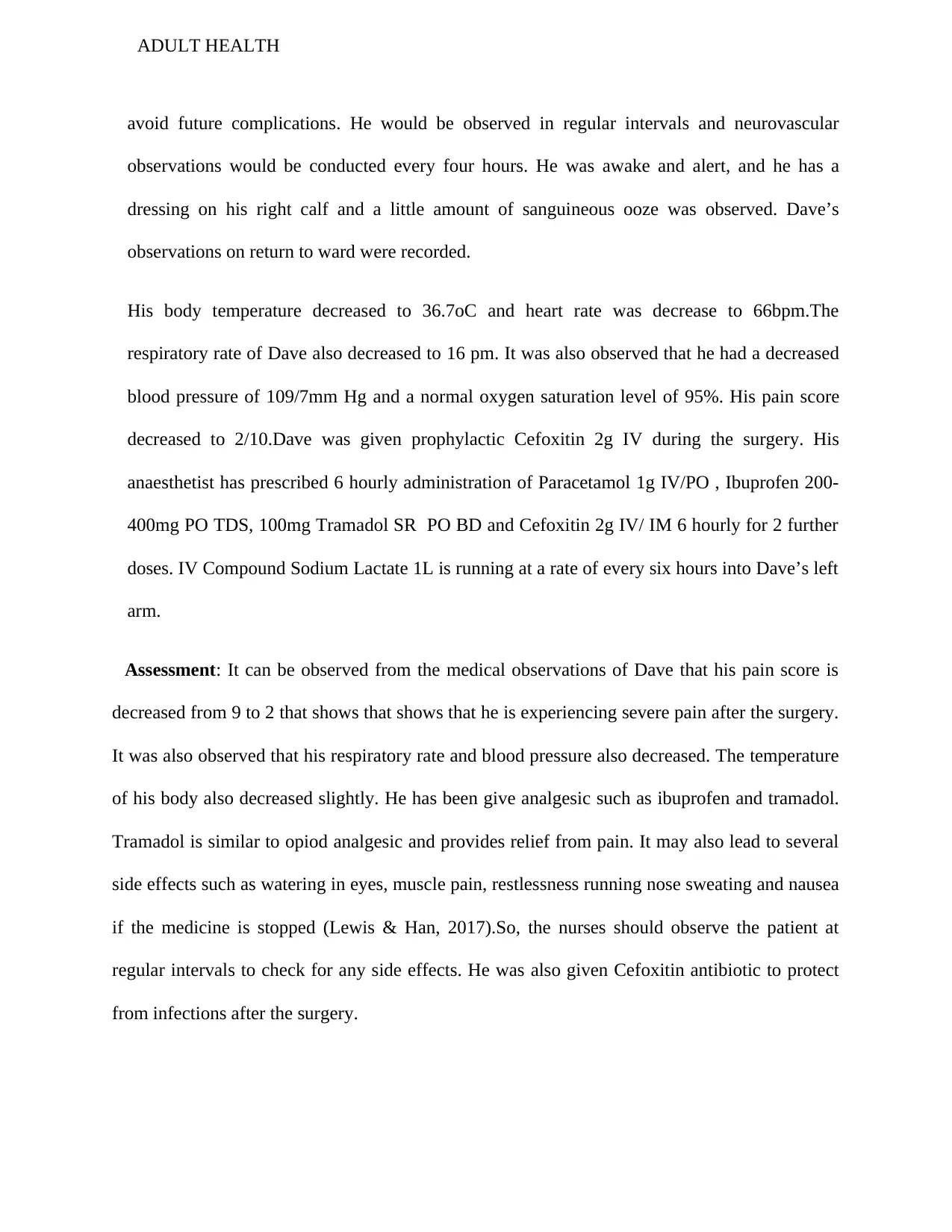
ADULT HEALTH
avoid future complications. He would be observed in regular intervals and neurovascular
observations would be conducted every four hours. He was awake and alert, and he has a
dressing on his right calf and a little amount of sanguineous ooze was observed. Dave’s
observations on return to ward were recorded.
His body temperature decreased to 36.7oC and heart rate was decrease to 66bpm.The
respiratory rate of Dave also decreased to 16 pm. It was also observed that he had a decreased
blood pressure of 109/7mm Hg and a normal oxygen saturation level of 95%. His pain score
decreased to 2/10.Dave was given prophylactic Cefoxitin 2g IV during the surgery. His
anaesthetist has prescribed 6 hourly administration of Paracetamol 1g IV/PO , Ibuprofen 200-
400mg PO TDS, 100mg Tramadol SR PO BD and Cefoxitin 2g IV/ IM 6 hourly for 2 further
doses. IV Compound Sodium Lactate 1L is running at a rate of every six hours into Dave’s left
arm.
Assessment: It can be observed from the medical observations of Dave that his pain score is
decreased from 9 to 2 that shows that shows that he is experiencing severe pain after the surgery.
It was also observed that his respiratory rate and blood pressure also decreased. The temperature
of his body also decreased slightly. He has been give analgesic such as ibuprofen and tramadol.
Tramadol is similar to opiod analgesic and provides relief from pain. It may also lead to several
side effects such as watering in eyes, muscle pain, restlessness running nose sweating and nausea
if the medicine is stopped (Lewis & Han, 2017).So, the nurses should observe the patient at
regular intervals to check for any side effects. He was also given Cefoxitin antibiotic to protect
from infections after the surgery.
avoid future complications. He would be observed in regular intervals and neurovascular
observations would be conducted every four hours. He was awake and alert, and he has a
dressing on his right calf and a little amount of sanguineous ooze was observed. Dave’s
observations on return to ward were recorded.
His body temperature decreased to 36.7oC and heart rate was decrease to 66bpm.The
respiratory rate of Dave also decreased to 16 pm. It was also observed that he had a decreased
blood pressure of 109/7mm Hg and a normal oxygen saturation level of 95%. His pain score
decreased to 2/10.Dave was given prophylactic Cefoxitin 2g IV during the surgery. His
anaesthetist has prescribed 6 hourly administration of Paracetamol 1g IV/PO , Ibuprofen 200-
400mg PO TDS, 100mg Tramadol SR PO BD and Cefoxitin 2g IV/ IM 6 hourly for 2 further
doses. IV Compound Sodium Lactate 1L is running at a rate of every six hours into Dave’s left
arm.
Assessment: It can be observed from the medical observations of Dave that his pain score is
decreased from 9 to 2 that shows that shows that he is experiencing severe pain after the surgery.
It was also observed that his respiratory rate and blood pressure also decreased. The temperature
of his body also decreased slightly. He has been give analgesic such as ibuprofen and tramadol.
Tramadol is similar to opiod analgesic and provides relief from pain. It may also lead to several
side effects such as watering in eyes, muscle pain, restlessness running nose sweating and nausea
if the medicine is stopped (Lewis & Han, 2017).So, the nurses should observe the patient at
regular intervals to check for any side effects. He was also given Cefoxitin antibiotic to protect
from infections after the surgery.
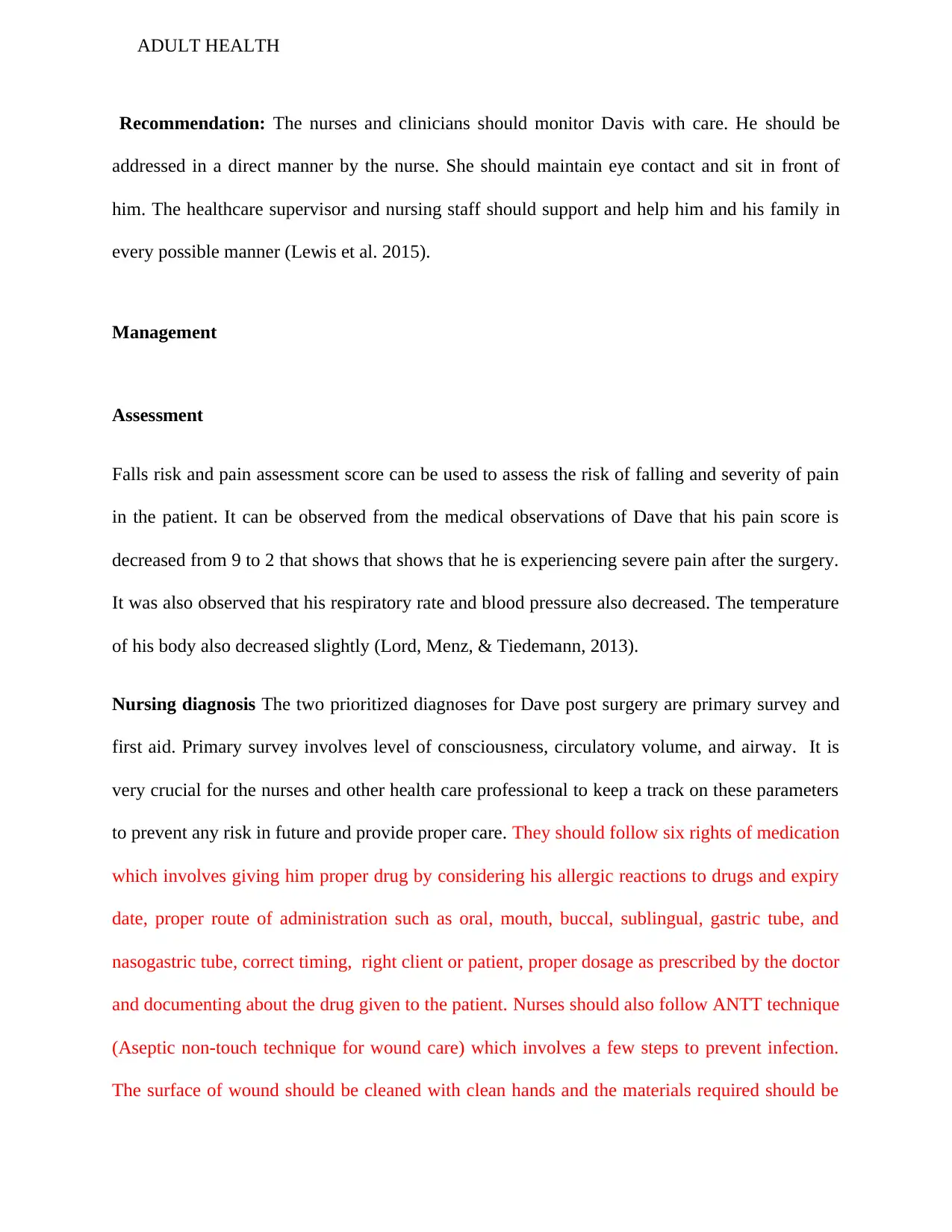
ADULT HEALTH
Recommendation: The nurses and clinicians should monitor Davis with care. He should be
addressed in a direct manner by the nurse. She should maintain eye contact and sit in front of
him. The healthcare supervisor and nursing staff should support and help him and his family in
every possible manner (Lewis et al. 2015).
Management
Assessment
Falls risk and pain assessment score can be used to assess the risk of falling and severity of pain
in the patient. It can be observed from the medical observations of Dave that his pain score is
decreased from 9 to 2 that shows that shows that he is experiencing severe pain after the surgery.
It was also observed that his respiratory rate and blood pressure also decreased. The temperature
of his body also decreased slightly (Lord, Menz, & Tiedemann, 2013).
Nursing diagnosis The two prioritized diagnoses for Dave post surgery are primary survey and
first aid. Primary survey involves level of consciousness, circulatory volume, and airway. It is
very crucial for the nurses and other health care professional to keep a track on these parameters
to prevent any risk in future and provide proper care. They should follow six rights of medication
which involves giving him proper drug by considering his allergic reactions to drugs and expiry
date, proper route of administration such as oral, mouth, buccal, sublingual, gastric tube, and
nasogastric tube, correct timing, right client or patient, proper dosage as prescribed by the doctor
and documenting about the drug given to the patient. Nurses should also follow ANTT technique
(Aseptic non-touch technique for wound care) which involves a few steps to prevent infection.
The surface of wound should be cleaned with clean hands and the materials required should be
Recommendation: The nurses and clinicians should monitor Davis with care. He should be
addressed in a direct manner by the nurse. She should maintain eye contact and sit in front of
him. The healthcare supervisor and nursing staff should support and help him and his family in
every possible manner (Lewis et al. 2015).
Management
Assessment
Falls risk and pain assessment score can be used to assess the risk of falling and severity of pain
in the patient. It can be observed from the medical observations of Dave that his pain score is
decreased from 9 to 2 that shows that shows that he is experiencing severe pain after the surgery.
It was also observed that his respiratory rate and blood pressure also decreased. The temperature
of his body also decreased slightly (Lord, Menz, & Tiedemann, 2013).
Nursing diagnosis The two prioritized diagnoses for Dave post surgery are primary survey and
first aid. Primary survey involves level of consciousness, circulatory volume, and airway. It is
very crucial for the nurses and other health care professional to keep a track on these parameters
to prevent any risk in future and provide proper care. They should follow six rights of medication
which involves giving him proper drug by considering his allergic reactions to drugs and expiry
date, proper route of administration such as oral, mouth, buccal, sublingual, gastric tube, and
nasogastric tube, correct timing, right client or patient, proper dosage as prescribed by the doctor
and documenting about the drug given to the patient. Nurses should also follow ANTT technique
(Aseptic non-touch technique for wound care) which involves a few steps to prevent infection.
The surface of wound should be cleaned with clean hands and the materials required should be
Secure Best Marks with AI Grader
Need help grading? Try our AI Grader for instant feedback on your assignments.
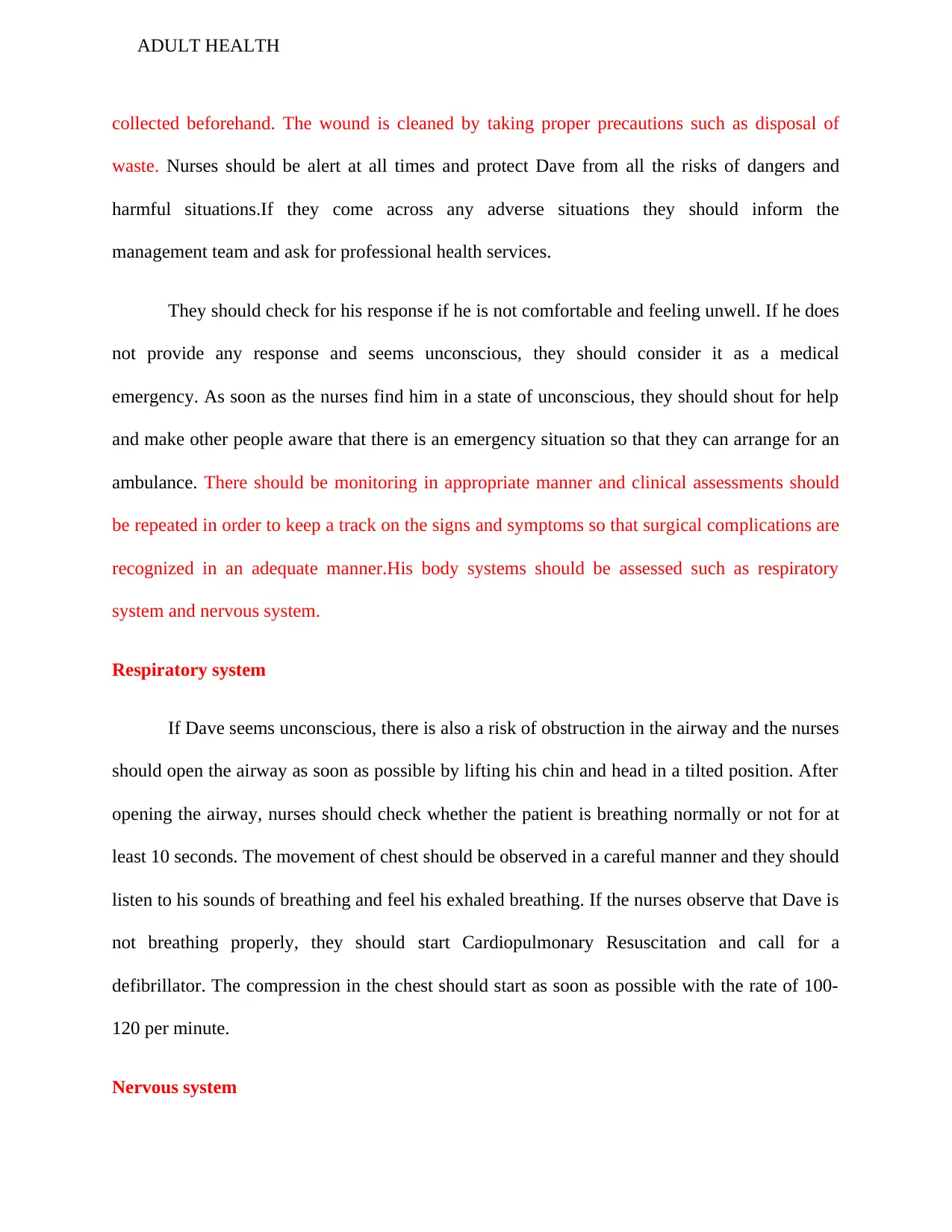
ADULT HEALTH
collected beforehand. The wound is cleaned by taking proper precautions such as disposal of
waste. Nurses should be alert at all times and protect Dave from all the risks of dangers and
harmful situations.If they come across any adverse situations they should inform the
management team and ask for professional health services.
They should check for his response if he is not comfortable and feeling unwell. If he does
not provide any response and seems unconscious, they should consider it as a medical
emergency. As soon as the nurses find him in a state of unconscious, they should shout for help
and make other people aware that there is an emergency situation so that they can arrange for an
ambulance. There should be monitoring in appropriate manner and clinical assessments should
be repeated in order to keep a track on the signs and symptoms so that surgical complications are
recognized in an adequate manner.His body systems should be assessed such as respiratory
system and nervous system.
Respiratory system
If Dave seems unconscious, there is also a risk of obstruction in the airway and the nurses
should open the airway as soon as possible by lifting his chin and head in a tilted position. After
opening the airway, nurses should check whether the patient is breathing normally or not for at
least 10 seconds. The movement of chest should be observed in a careful manner and they should
listen to his sounds of breathing and feel his exhaled breathing. If the nurses observe that Dave is
not breathing properly, they should start Cardiopulmonary Resuscitation and call for a
defibrillator. The compression in the chest should start as soon as possible with the rate of 100-
120 per minute.
Nervous system
collected beforehand. The wound is cleaned by taking proper precautions such as disposal of
waste. Nurses should be alert at all times and protect Dave from all the risks of dangers and
harmful situations.If they come across any adverse situations they should inform the
management team and ask for professional health services.
They should check for his response if he is not comfortable and feeling unwell. If he does
not provide any response and seems unconscious, they should consider it as a medical
emergency. As soon as the nurses find him in a state of unconscious, they should shout for help
and make other people aware that there is an emergency situation so that they can arrange for an
ambulance. There should be monitoring in appropriate manner and clinical assessments should
be repeated in order to keep a track on the signs and symptoms so that surgical complications are
recognized in an adequate manner.His body systems should be assessed such as respiratory
system and nervous system.
Respiratory system
If Dave seems unconscious, there is also a risk of obstruction in the airway and the nurses
should open the airway as soon as possible by lifting his chin and head in a tilted position. After
opening the airway, nurses should check whether the patient is breathing normally or not for at
least 10 seconds. The movement of chest should be observed in a careful manner and they should
listen to his sounds of breathing and feel his exhaled breathing. If the nurses observe that Dave is
not breathing properly, they should start Cardiopulmonary Resuscitation and call for a
defibrillator. The compression in the chest should start as soon as possible with the rate of 100-
120 per minute.
Nervous system
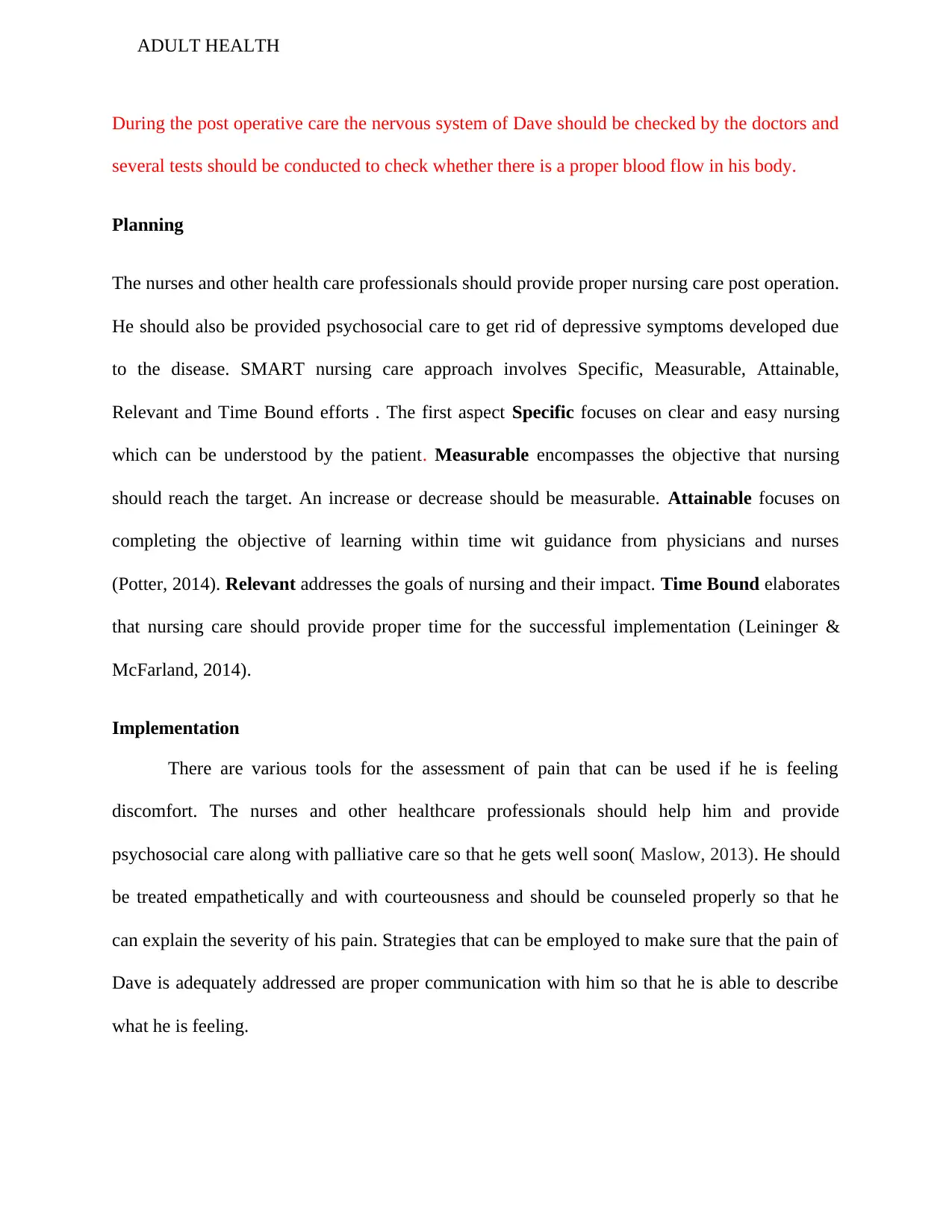
ADULT HEALTH
During the post operative care the nervous system of Dave should be checked by the doctors and
several tests should be conducted to check whether there is a proper blood flow in his body.
Planning
The nurses and other health care professionals should provide proper nursing care post operation.
He should also be provided psychosocial care to get rid of depressive symptoms developed due
to the disease. SMART nursing care approach involves Specific, Measurable, Attainable,
Relevant and Time Bound efforts . The first aspect Specific focuses on clear and easy nursing
which can be understood by the patient. Measurable encompasses the objective that nursing
should reach the target. An increase or decrease should be measurable. Attainable focuses on
completing the objective of learning within time wit guidance from physicians and nurses
(Potter, 2014). Relevant addresses the goals of nursing and their impact. Time Bound elaborates
that nursing care should provide proper time for the successful implementation (Leininger &
McFarland, 2014).
Implementation
There are various tools for the assessment of pain that can be used if he is feeling
discomfort. The nurses and other healthcare professionals should help him and provide
psychosocial care along with palliative care so that he gets well soon( Maslow, 2013). He should
be treated empathetically and with courteousness and should be counseled properly so that he
can explain the severity of his pain. Strategies that can be employed to make sure that the pain of
Dave is adequately addressed are proper communication with him so that he is able to describe
what he is feeling.
During the post operative care the nervous system of Dave should be checked by the doctors and
several tests should be conducted to check whether there is a proper blood flow in his body.
Planning
The nurses and other health care professionals should provide proper nursing care post operation.
He should also be provided psychosocial care to get rid of depressive symptoms developed due
to the disease. SMART nursing care approach involves Specific, Measurable, Attainable,
Relevant and Time Bound efforts . The first aspect Specific focuses on clear and easy nursing
which can be understood by the patient. Measurable encompasses the objective that nursing
should reach the target. An increase or decrease should be measurable. Attainable focuses on
completing the objective of learning within time wit guidance from physicians and nurses
(Potter, 2014). Relevant addresses the goals of nursing and their impact. Time Bound elaborates
that nursing care should provide proper time for the successful implementation (Leininger &
McFarland, 2014).
Implementation
There are various tools for the assessment of pain that can be used if he is feeling
discomfort. The nurses and other healthcare professionals should help him and provide
psychosocial care along with palliative care so that he gets well soon( Maslow, 2013). He should
be treated empathetically and with courteousness and should be counseled properly so that he
can explain the severity of his pain. Strategies that can be employed to make sure that the pain of
Dave is adequately addressed are proper communication with him so that he is able to describe
what he is feeling.
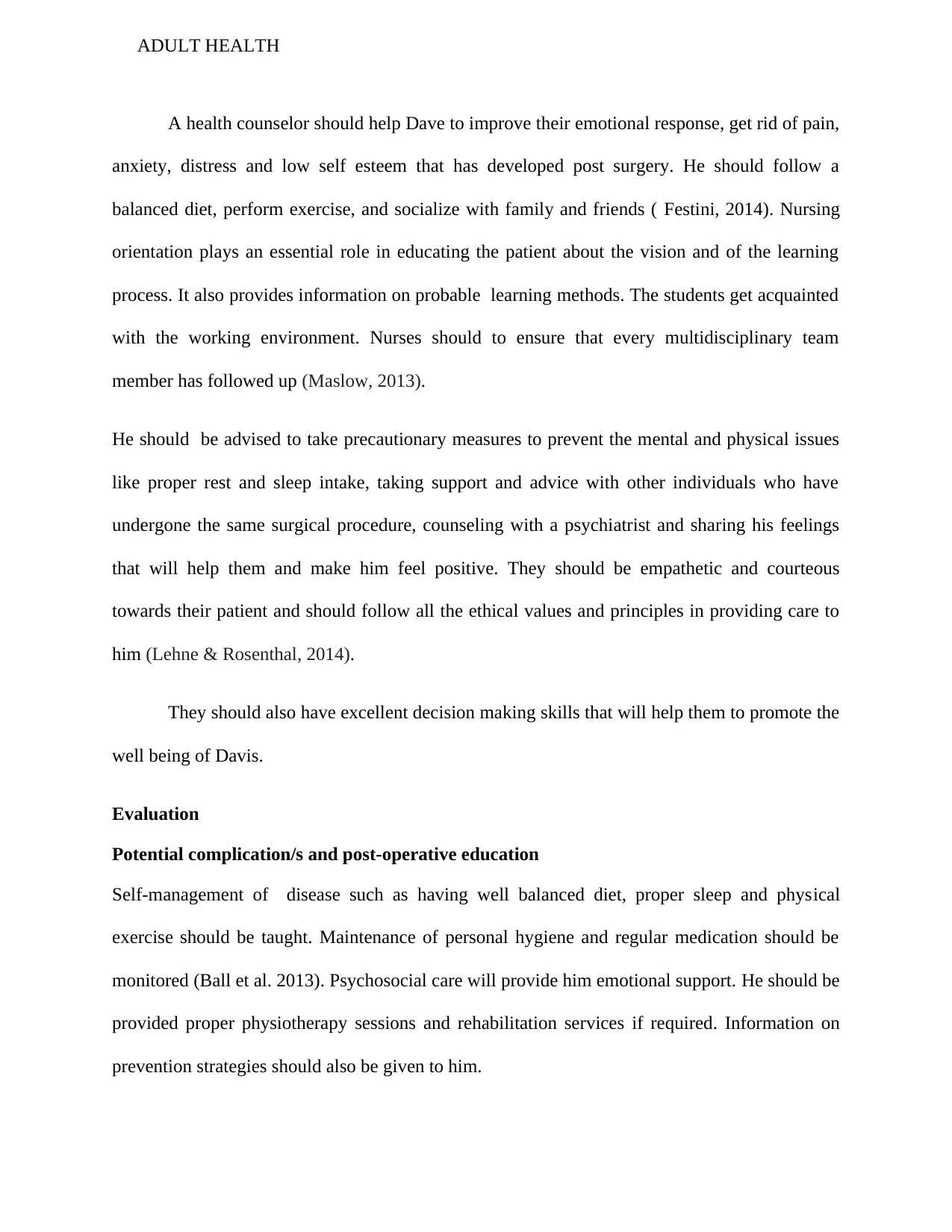
ADULT HEALTH
A health counselor should help Dave to improve their emotional response, get rid of pain,
anxiety, distress and low self esteem that has developed post surgery. He should follow a
balanced diet, perform exercise, and socialize with family and friends ( Festini, 2014). Nursing
orientation plays an essential role in educating the patient about the vision and of the learning
process. It also provides information on probable learning methods. The students get acquainted
with the working environment. Nurses should to ensure that every multidisciplinary team
member has followed up (Maslow, 2013).
He should be advised to take precautionary measures to prevent the mental and physical issues
like proper rest and sleep intake, taking support and advice with other individuals who have
undergone the same surgical procedure, counseling with a psychiatrist and sharing his feelings
that will help them and make him feel positive. They should be empathetic and courteous
towards their patient and should follow all the ethical values and principles in providing care to
him (Lehne & Rosenthal, 2014).
They should also have excellent decision making skills that will help them to promote the
well being of Davis.
Evaluation
Potential complication/s and post-operative education
Self-management of disease such as having well balanced diet, proper sleep and physical
exercise should be taught. Maintenance of personal hygiene and regular medication should be
monitored (Ball et al. 2013). Psychosocial care will provide him emotional support. He should be
provided proper physiotherapy sessions and rehabilitation services if required. Information on
prevention strategies should also be given to him.
A health counselor should help Dave to improve their emotional response, get rid of pain,
anxiety, distress and low self esteem that has developed post surgery. He should follow a
balanced diet, perform exercise, and socialize with family and friends ( Festini, 2014). Nursing
orientation plays an essential role in educating the patient about the vision and of the learning
process. It also provides information on probable learning methods. The students get acquainted
with the working environment. Nurses should to ensure that every multidisciplinary team
member has followed up (Maslow, 2013).
He should be advised to take precautionary measures to prevent the mental and physical issues
like proper rest and sleep intake, taking support and advice with other individuals who have
undergone the same surgical procedure, counseling with a psychiatrist and sharing his feelings
that will help them and make him feel positive. They should be empathetic and courteous
towards their patient and should follow all the ethical values and principles in providing care to
him (Lehne & Rosenthal, 2014).
They should also have excellent decision making skills that will help them to promote the
well being of Davis.
Evaluation
Potential complication/s and post-operative education
Self-management of disease such as having well balanced diet, proper sleep and physical
exercise should be taught. Maintenance of personal hygiene and regular medication should be
monitored (Ball et al. 2013). Psychosocial care will provide him emotional support. He should be
provided proper physiotherapy sessions and rehabilitation services if required. Information on
prevention strategies should also be given to him.
Paraphrase This Document
Need a fresh take? Get an instant paraphrase of this document with our AI Paraphraser
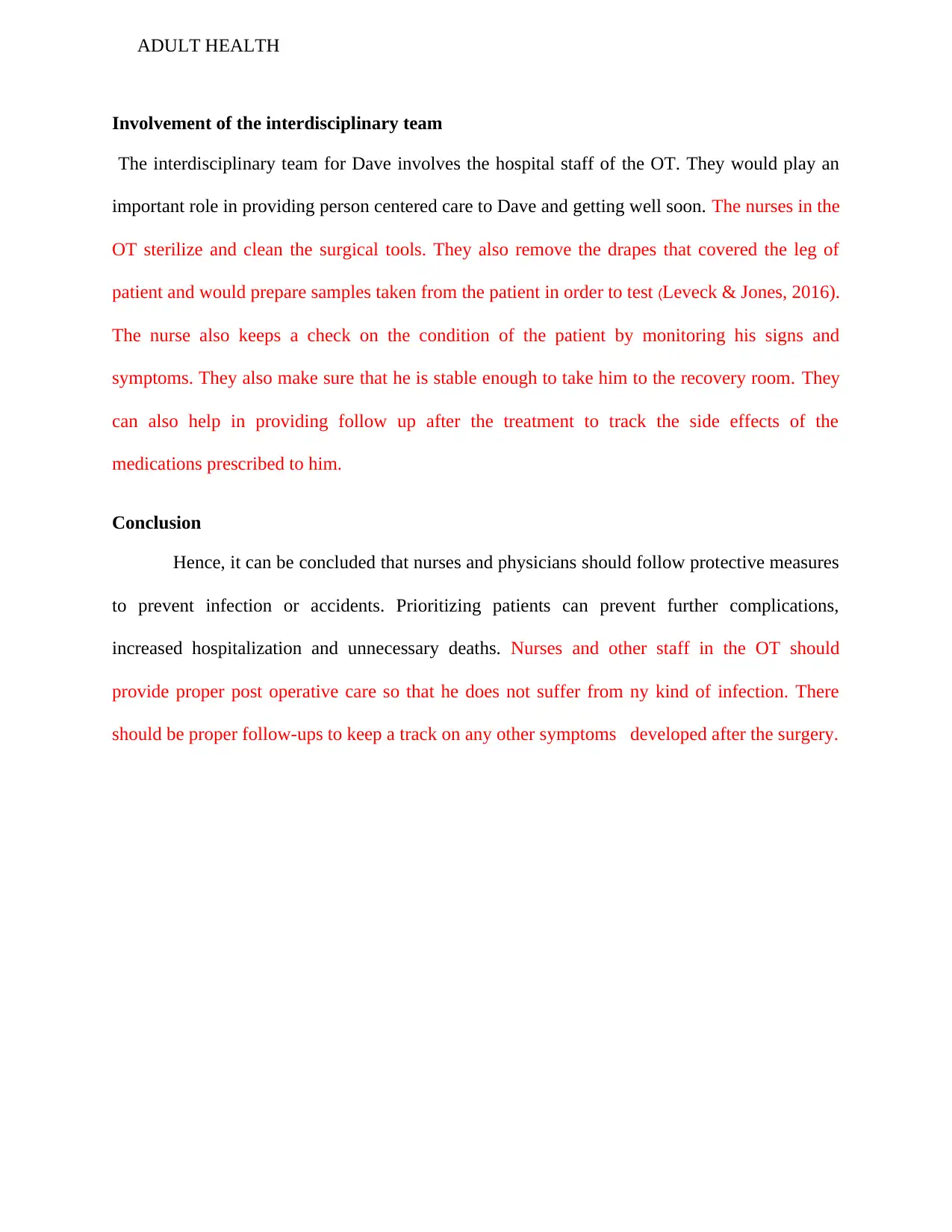
ADULT HEALTH
Involvement of the interdisciplinary team
The interdisciplinary team for Dave involves the hospital staff of the OT. They would play an
important role in providing person centered care to Dave and getting well soon. The nurses in the
OT sterilize and clean the surgical tools. They also remove the drapes that covered the leg of
patient and would prepare samples taken from the patient in order to test (Leveck & Jones, 2016).
The nurse also keeps a check on the condition of the patient by monitoring his signs and
symptoms. They also make sure that he is stable enough to take him to the recovery room. They
can also help in providing follow up after the treatment to track the side effects of the
medications prescribed to him.
Conclusion
Hence, it can be concluded that nurses and physicians should follow protective measures
to prevent infection or accidents. Prioritizing patients can prevent further complications,
increased hospitalization and unnecessary deaths. Nurses and other staff in the OT should
provide proper post operative care so that he does not suffer from ny kind of infection. There
should be proper follow-ups to keep a track on any other symptoms developed after the surgery.
Involvement of the interdisciplinary team
The interdisciplinary team for Dave involves the hospital staff of the OT. They would play an
important role in providing person centered care to Dave and getting well soon. The nurses in the
OT sterilize and clean the surgical tools. They also remove the drapes that covered the leg of
patient and would prepare samples taken from the patient in order to test (Leveck & Jones, 2016).
The nurse also keeps a check on the condition of the patient by monitoring his signs and
symptoms. They also make sure that he is stable enough to take him to the recovery room. They
can also help in providing follow up after the treatment to track the side effects of the
medications prescribed to him.
Conclusion
Hence, it can be concluded that nurses and physicians should follow protective measures
to prevent infection or accidents. Prioritizing patients can prevent further complications,
increased hospitalization and unnecessary deaths. Nurses and other staff in the OT should
provide proper post operative care so that he does not suffer from ny kind of infection. There
should be proper follow-ups to keep a track on any other symptoms developed after the surgery.
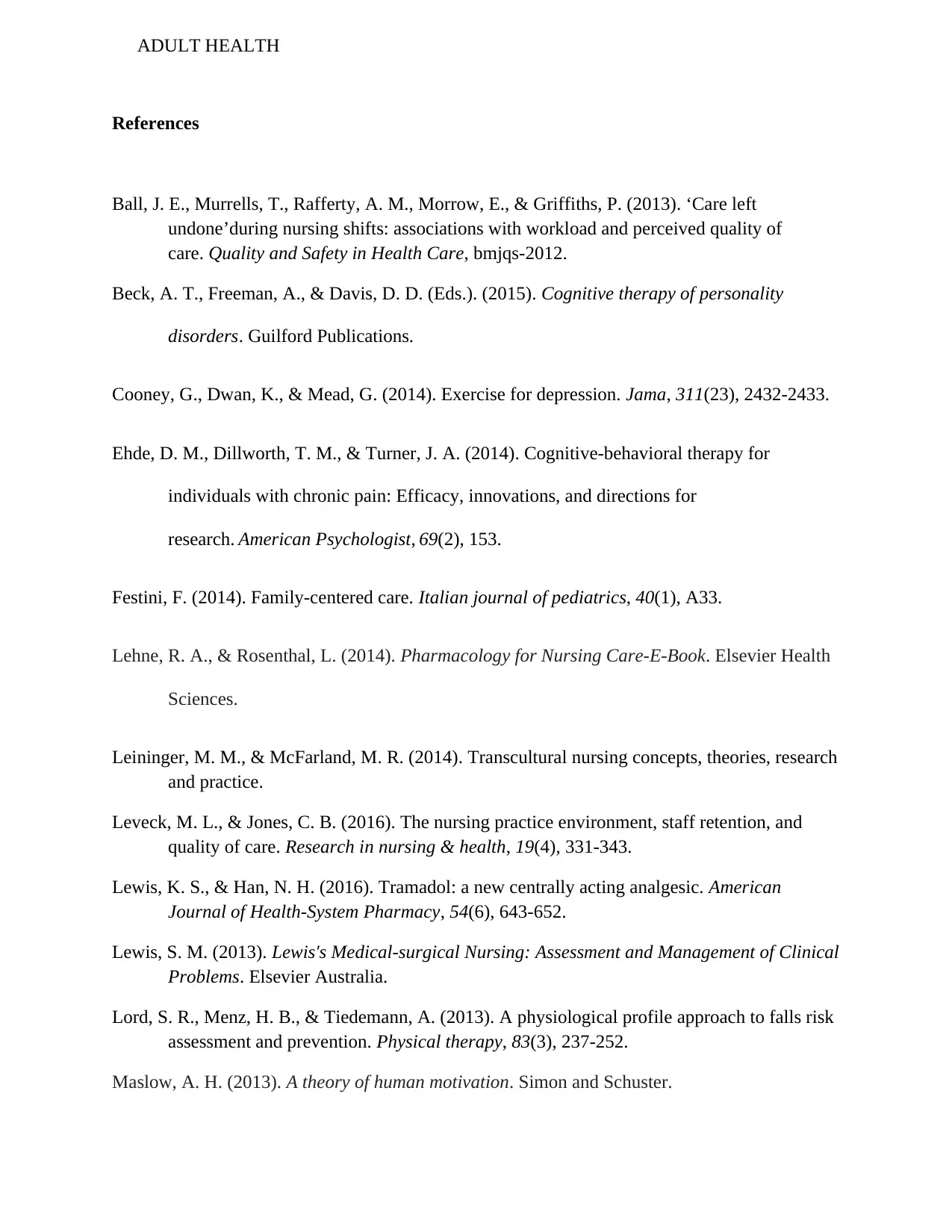
ADULT HEALTH
References
Ball, J. E., Murrells, T., Rafferty, A. M., Morrow, E., & Griffiths, P. (2013). ‘Care left
undone’during nursing shifts: associations with workload and perceived quality of
care. Quality and Safety in Health Care, bmjqs-2012.
Beck, A. T., Freeman, A., & Davis, D. D. (Eds.). (2015). Cognitive therapy of personality
disorders. Guilford Publications.
Cooney, G., Dwan, K., & Mead, G. (2014). Exercise for depression. Jama, 311(23), 2432-2433.
Ehde, D. M., Dillworth, T. M., & Turner, J. A. (2014). Cognitive-behavioral therapy for
individuals with chronic pain: Efficacy, innovations, and directions for
research. American Psychologist, 69(2), 153.
Festini, F. (2014). Family-centered care. Italian journal of pediatrics, 40(1), A33.
Lehne, R. A., & Rosenthal, L. (2014). Pharmacology for Nursing Care-E-Book. Elsevier Health
Sciences.
Leininger, M. M., & McFarland, M. R. (2014). Transcultural nursing concepts, theories, research
and practice.
Leveck, M. L., & Jones, C. B. (2016). The nursing practice environment, staff retention, and
quality of care. Research in nursing & health, 19(4), 331-343.
Lewis, K. S., & Han, N. H. (2016). Tramadol: a new centrally acting analgesic. American
Journal of Health-System Pharmacy, 54(6), 643-652.
Lewis, S. M. (2013). Lewis's Medical-surgical Nursing: Assessment and Management of Clinical
Problems. Elsevier Australia.
Lord, S. R., Menz, H. B., & Tiedemann, A. (2013). A physiological profile approach to falls risk
assessment and prevention. Physical therapy, 83(3), 237-252.
Maslow, A. H. (2013). A theory of human motivation. Simon and Schuster.
References
Ball, J. E., Murrells, T., Rafferty, A. M., Morrow, E., & Griffiths, P. (2013). ‘Care left
undone’during nursing shifts: associations with workload and perceived quality of
care. Quality and Safety in Health Care, bmjqs-2012.
Beck, A. T., Freeman, A., & Davis, D. D. (Eds.). (2015). Cognitive therapy of personality
disorders. Guilford Publications.
Cooney, G., Dwan, K., & Mead, G. (2014). Exercise for depression. Jama, 311(23), 2432-2433.
Ehde, D. M., Dillworth, T. M., & Turner, J. A. (2014). Cognitive-behavioral therapy for
individuals with chronic pain: Efficacy, innovations, and directions for
research. American Psychologist, 69(2), 153.
Festini, F. (2014). Family-centered care. Italian journal of pediatrics, 40(1), A33.
Lehne, R. A., & Rosenthal, L. (2014). Pharmacology for Nursing Care-E-Book. Elsevier Health
Sciences.
Leininger, M. M., & McFarland, M. R. (2014). Transcultural nursing concepts, theories, research
and practice.
Leveck, M. L., & Jones, C. B. (2016). The nursing practice environment, staff retention, and
quality of care. Research in nursing & health, 19(4), 331-343.
Lewis, K. S., & Han, N. H. (2016). Tramadol: a new centrally acting analgesic. American
Journal of Health-System Pharmacy, 54(6), 643-652.
Lewis, S. M. (2013). Lewis's Medical-surgical Nursing: Assessment and Management of Clinical
Problems. Elsevier Australia.
Lord, S. R., Menz, H. B., & Tiedemann, A. (2013). A physiological profile approach to falls risk
assessment and prevention. Physical therapy, 83(3), 237-252.
Maslow, A. H. (2013). A theory of human motivation. Simon and Schuster.
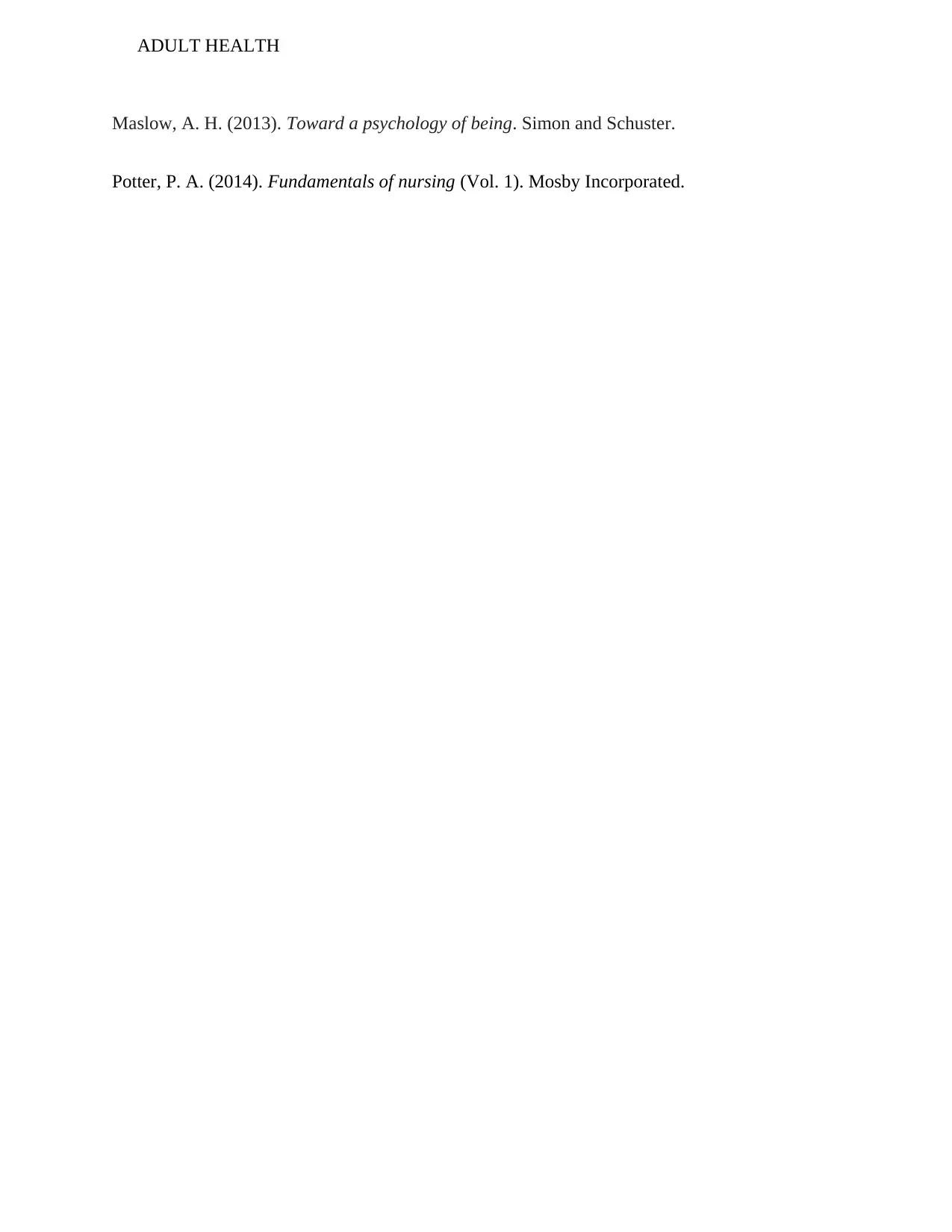
ADULT HEALTH
Maslow, A. H. (2013). Toward a psychology of being. Simon and Schuster.
Potter, P. A. (2014). Fundamentals of nursing (Vol. 1). Mosby Incorporated.
Maslow, A. H. (2013). Toward a psychology of being. Simon and Schuster.
Potter, P. A. (2014). Fundamentals of nursing (Vol. 1). Mosby Incorporated.
1 out of 10
Related Documents
Your All-in-One AI-Powered Toolkit for Academic Success.
+13062052269
info@desklib.com
Available 24*7 on WhatsApp / Email
![[object Object]](/_next/static/media/star-bottom.7253800d.svg)
Unlock your academic potential
© 2024 | Zucol Services PVT LTD | All rights reserved.
